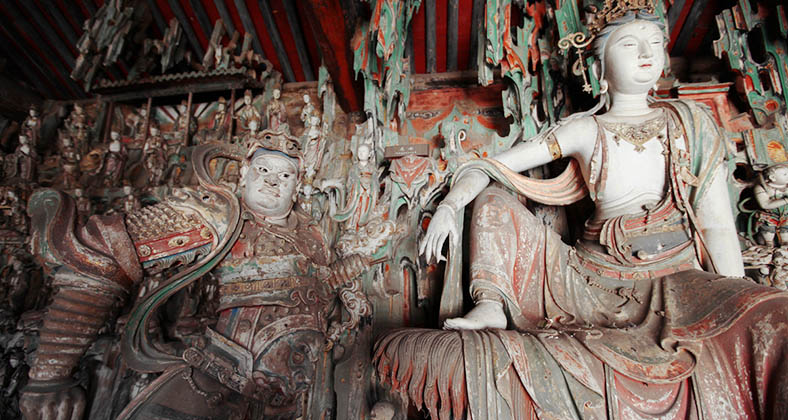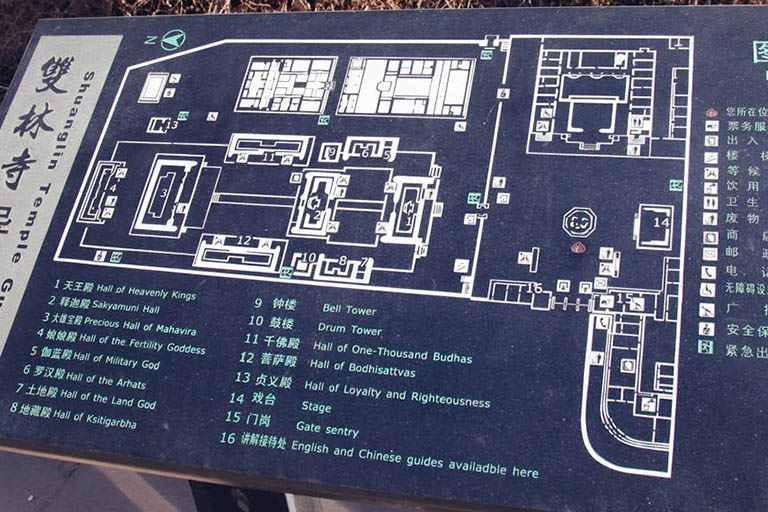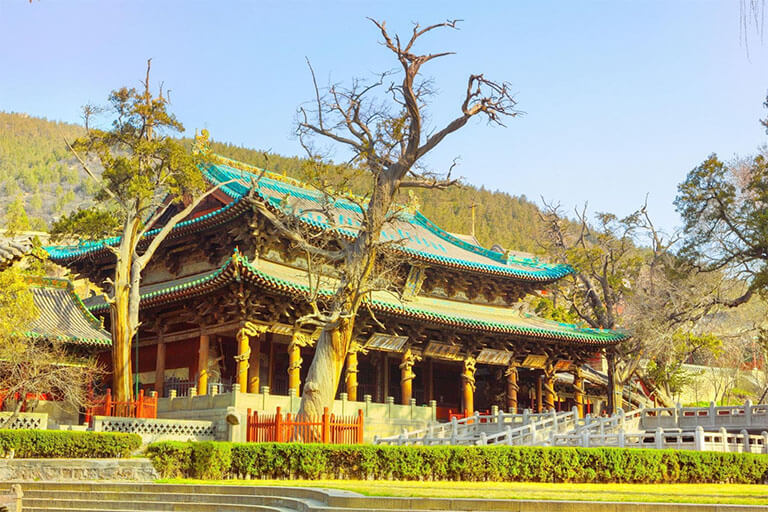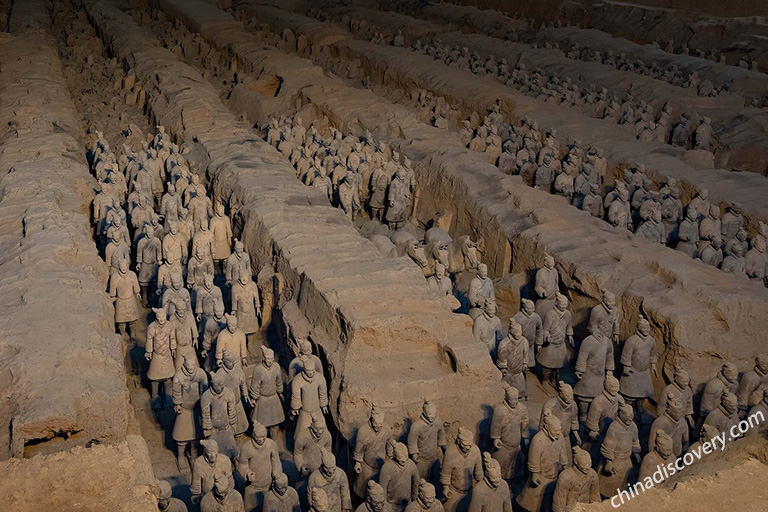History of Shuanglin Temple
Shuanglin Temple (formerly called Zhongdu Temple) is one of the important national Buddhist temples in Han areas and a National AAAA tourist spot, which has been listed as a UNESCO World Cultural Heritage site with Pingyao Ancient City, Zhenguo Temple in 1997. According to scripts carved on the stele of Song Dynasty (11th AD), Shuanglin Temple was reconstructed in North Qi Dynasty in about 571 AD. That means, the temple has a very long history of nearly 1,500 years. It is said that long ago, Shuanglin Temple had many majestic buildings, endless stream of pilgrims and visitors. However, after suffering from fire and wars, it became ramshackle in Yuan Dynasty and got many rebuilding in the following Ming and Qing Dynasties. Not famous as Pingyao Ancient City nearby, very few tourists can be found in Shuanglin Temple. And most travelers think the temple is not very maintained, most sculptures needs cleaning and restoration.
✔ Popular Shuanglin Temple Tours: 2 Days Classic Pingyao Ancient City Tour / 3 Days Pingyao Cultural Discovery Tour
Layout and Structure of Shuanglin Temple
Covering an area of 15,000 square meters and facing south, Shuanglin Temple is a temple complex mainly made up of two areas. The west part has 10 temple halls located along central axis in three courtyards. Hall of Heavenly Kings, Sakyamuni Hall, The Front Courtyard, Hall of Arhats, Hall of the Land God and Hall of Ksitigarbha are in the forecourt. In the middle area, there are Precious Hall of Mahavira and Hall of One-Thousand Buddhas, Hall of Bodhisattva on the sides. Hall of the Fertility Goddess and Hall of Loyalty and Righteousness are in the backyard. The east area contains Buddhist halls, scriptures houses (already used by local primary school). To protect the temple, a red stone wall was built in Ming Dynasty as outer defense, which makes the temple like a small castle.
Top Highlights to See in Shuanglin Temple
Hall of Heavenly Kings 天王殿
Enter through the arched gate, Hall of Heavenly Kings is the first stop jumping into your sight. The main hall is five wide, three deep with a hanging mountain-style roof. Under the eave, a vertical plaque was written four words - “天竺胜境” (a wonder land of Buddha) and Ming Dynasty’s preface in firm strokes. The most attracting part is the four giant sculptures of Heavenly Kings standing at the entrance. Each one is about three meters tall, carrying their special instruments. All visitors are full of admiration for the powerful gestures and vivid exaggerated fierce looks where black glazed balls inlaid in their eyes.
There are iron fences built to protect the cultural relics. Inside the hall, you can see a grand statue group of Maitreya Bodhisattva, Brahma and Indra, four taller Heavenly Kings and eight Bodhisattvas. All are imposing in size and delicate in details, specially the four Kings who surely bring you the strong visual impact at your first sight. Behind the Maitreya Bodhisattva sculpture, you can view a wall hanging sculpture of Avalokitesvara sitting on a god dog on the waves of the sea.
Sakyamuni Hall 释迦殿
Sakyamuni Hall is the top famous and most important hall in Shuanglin Temple. It lies between the Drum Tower and Bell Tower. Here the plaque has words - “灵鹫遗风” in a plain and simple feature. The most striking sculptures in Sakyamuni Hall is the Sakyamuni sitting on lotus platform, Manjushri Buddhisattva holding a Buddhist book (presenting wisdom) and Samantabhadra taking a lotus (meaning purification of all distress) and standing on his sides. Another amazing highlight in the hall is the serial sculptures story on the walls. Diverse carving skills are adopted, like circular engraving, deep anaglyph, basso-relievo, etc. Those complicated and superb combination aims to unfold the legendary life of Sakyamuni - the found of Buddhism. Though all story of Sakyamuni come from India, all figures are localized in distinctive Chinese style of Ming Dynasty. Ready to enjoy a 3D Buddha movie with explanation from your tour guide. On the back screen wall, there is also a hanging sculpture of Avalokitesvara whose peace impression makes a sharp contrast with the rough seas.
Precious Hall of Mahavira 大雄宝殿
Located in the second courtyard, the Precious Hall of Mahavira, rebuilt in early Ming Dynasty is the tallest building in Shuanglin Temple. The corridor, cylinder, frame structure, window decorations are much beautiful than other halls. Main statues inside are the Three-Bodies of the Buddha (Trikaya) with Manjushri Buddhisattva and Samantabhadra standing by his sides, an Amitabha (receiving Buddha) in the front. Because there sculptures got rich colored painted in Qing Dynasty, they look quite new, less dusty but lack of authentic flavor.
Hall of One-Thousand Buddhas 千佛殿
Lying in the east of the middle courtyard, Hall of Bodhisattva has two of the best sculptures of Shuanglin Temple - a sitting Avalokitesvara with right foot up and a Wei Tuo (Skanda, a protector of the Buddhas) by her side. The active and bold design of the sitting position of the Avalokitesvara perfectly keeps the effigy balance and makes her a naturally fair maiden. The 1.6-meter tall Wei Tuo sideward is a rare-seen artistic masterpiece of Ming Dynasty painted sculpture, a must-see treasure during your Shuanglin Temple tour. His lifelike facial expression, mighty and hyperbolic posture and wonderful integration of quiescent and dynamic feelings win him the top-level miracle among the artworks on the same subject and the best spokesman of Shuanglin Temple.
The outer walls remain some residual murals from Ming Dynasty, while the interior walls around are filled with rows of hanging figures of Bodhisattvas. There are 500 sculptures in total, some are riding mythical beasts, and some are sitting on the auspicious clouds. On the windowsills and near the gate, you can see nearly 30 small-sized statues whose prototypes are the ordinary people in nearby villages. Now they are good evidence of the development of Ming dynasty costumes.
Hall of Bodhisattvas 菩萨殿
The magnificent sculpture of Thousand-hand Bodhisattva is undoubtedly the most impressive symbol in Shuanglin Temple. She has a serene look, delicate skin, wears a beautiful cassock and stretches her 26 hands to all directions to rescue the suffering people. Sakra and Brahma are two guardian Buddhas standing on her left and right-hand sides. Also, over 400 hanging sculptures of Bodhisattvas were caved on the walls inside. Each varies from others in facial expression and gestures. The layered figurines skillfully establish a pure land of Buddha.
Besides sightseeing of the main highlights in the former halls, with more time, tourists can also see statues of Guan Yu (a military hero serving Liu Bei during late Eastern Han Dynasty) and his life story scenes in Hall of Military God (珈蓝殿), sculptures of eighteen Song Dynasty Arhats making a pilgrimage to the Bodhisattva in Hall of Arhats (罗汉殿), august Kshitigarbha, Hades and Osiris in Hall of Kshitigarbha and other folk sculptures in the end courtyard.
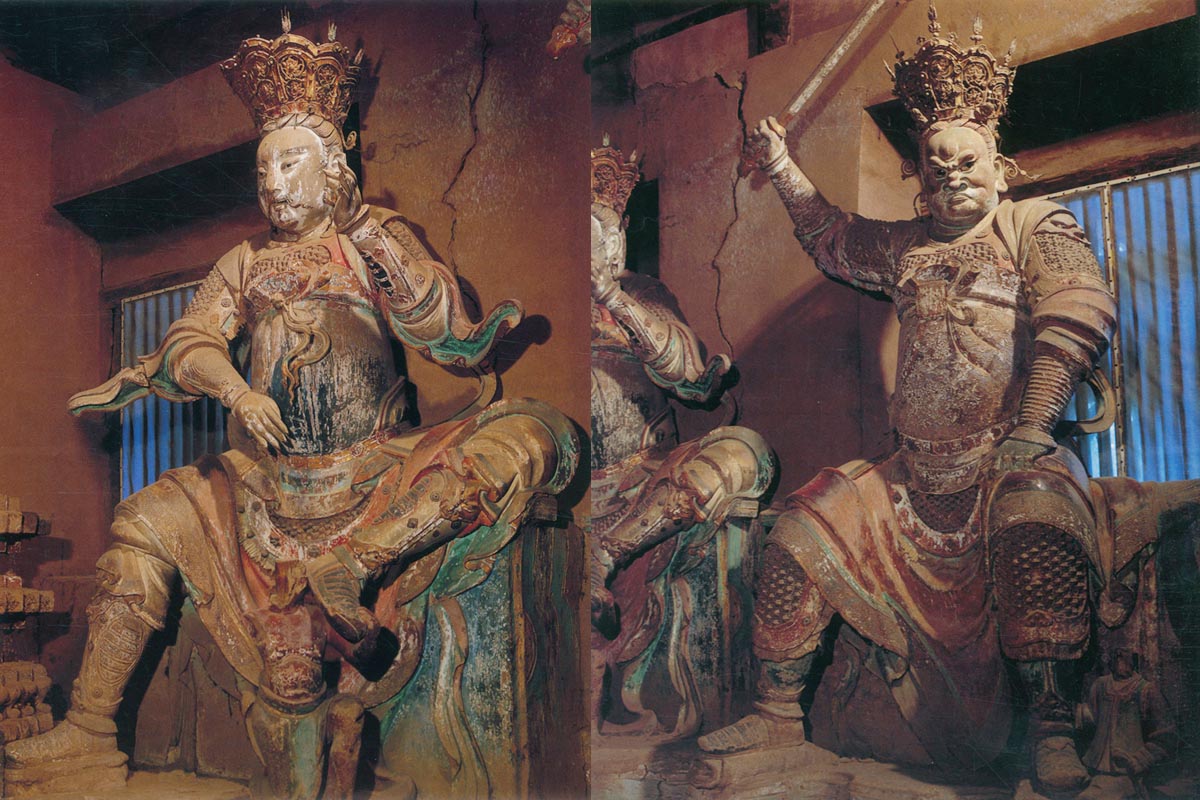 Majestic Sculptures of Heavenly Kings
Majestic Sculptures of Heavenly Kings
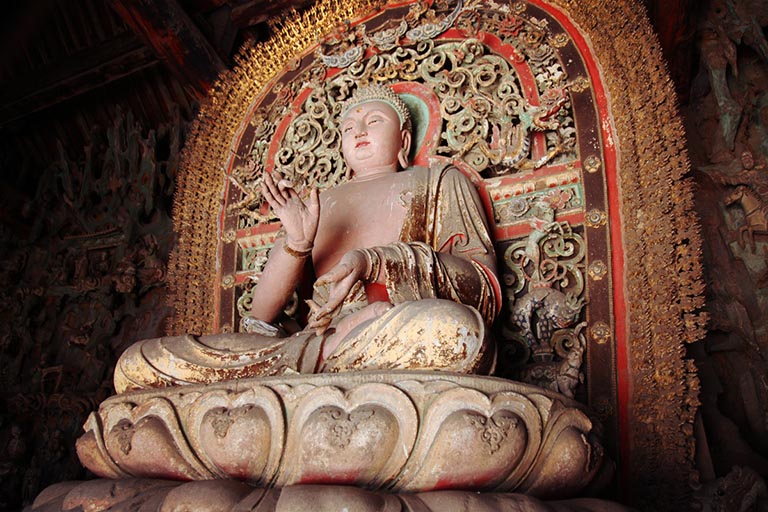 Sakyamuni Sitting on Lotus in Sakyamuni Hall
Sakyamuni Sitting on Lotus in Sakyamuni Hall
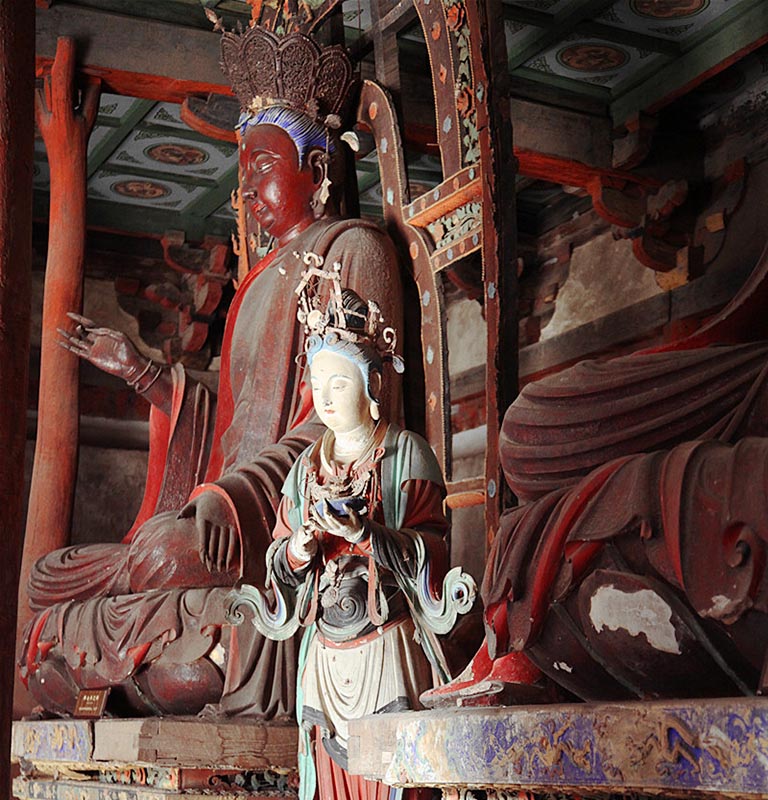 Three-Bodies of the Buddha in Precious Hall of Mahavira
Three-Bodies of the Buddha in Precious Hall of Mahavira
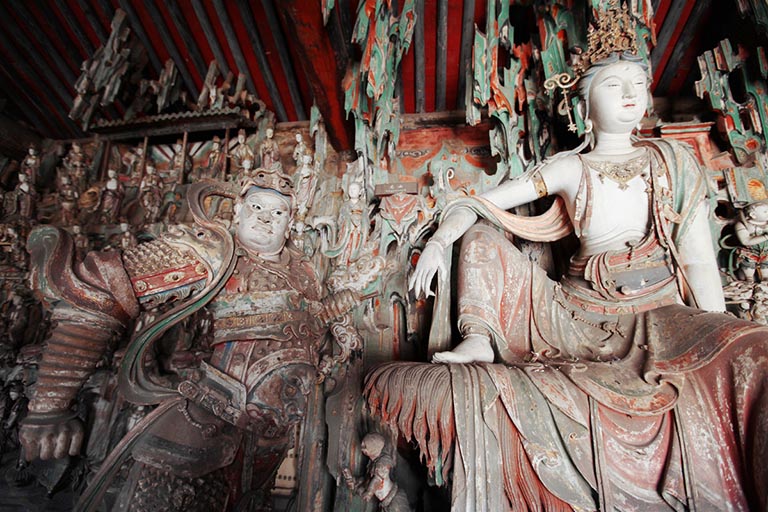 Avalokitesvara and Wei Tuo
Avalokitesvara and Wei Tuo
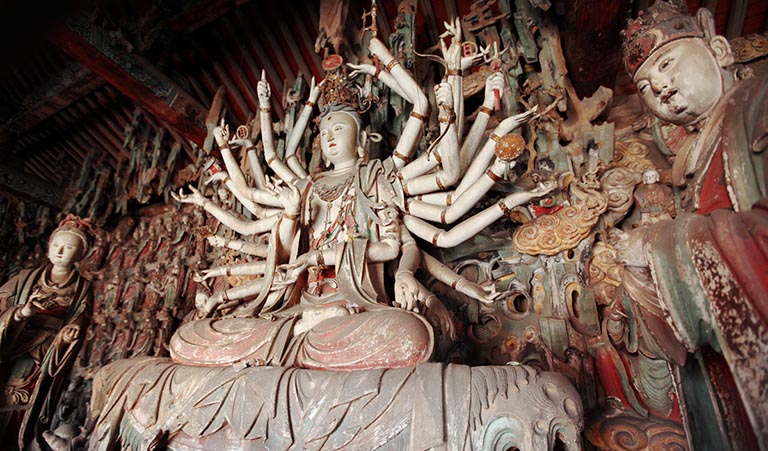 Thousand-hand Bodhisattva
Thousand-hand Bodhisattva
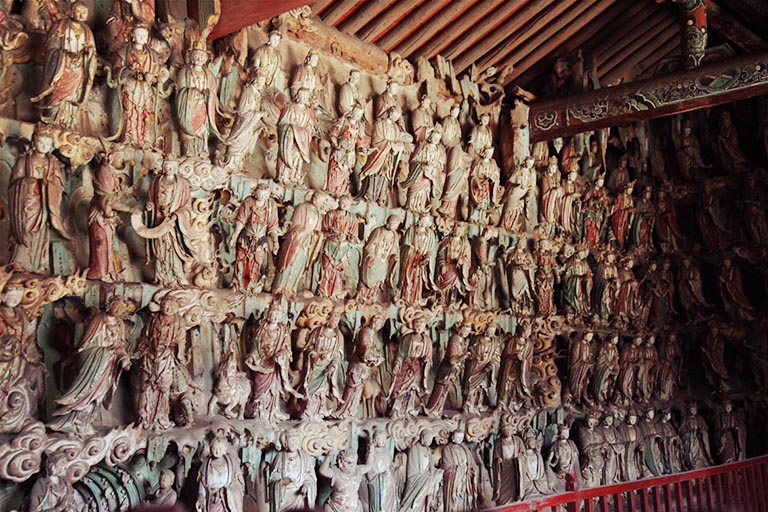 Sculpture Walls in Hall of Bodhisattvas
Sculpture Walls in Hall of Bodhisattvas
How to Get to Shuanglin Temple
Shuanglin Temple is located in Qiaotou Village, west of Pingyao County, Jinzhong City, Shanxi Province, just 6 km southwest of the Pingyao Ancient City, around 400 km (5 hours’ driving ) from Datong Yungang Grottoes, 300 km (4 hours’ driving) from Wutaishan Mountain and Hukou Waterfall. If you want to visit Shuanglin Temple, normally, you need to get to Pingyao first and most tourist get to Pingyao by train from Beijing, Datong, Taiyuan Xian and other Chinese cities. After arrival, you need to make extra transfer to Shuanglin Temple from the station. When in Pingyao, it’s very easy and convenient to visit the temple from Pingyao Ancient City.
- Pingyao Ancient City Railway Station - Shuanglin Temple: about 4 km, within 10 minutes’ driving /25-30 minutes by Pingyao City Bus 108;
- Pingyao Railway Station - Shuanglin Temple: about 6 km, nearly 10 minutes’ driving;
- Pingyao Ancient City - Shuanglin Temple: about 6 km, 15-20 minutes by car and 40 minutes by Pingyao City Bus 108;
- Zhenguo Temple - Shuanglin Temple: about 20 km, 0.5 hours’ driving;
- Qiao’s Family Compound - Shuanglin Temple: about 45 km, 1 hour’s driving;
- Wang’s Family Compound - Shuanglin Temple: about 50 km, 1 hour’s driving.
Tourist Attractions Near Shuanglin Temple
Pingyao Ancient City (6 km from Shuanglin Temple)
Recommended Visiting Time: half a day ~ 1 full day
Through Ticket:CNY 125 for 22 sites
As a national AAAAA tourist attraction in China and a UNESCO World Heritage Site, Pingyao Ancient City is one of the best-preserved ancient cities in China, a remarking example of Han Chinese city of Ming and Qing Dynasties. With a long history of over 2,700 years, it has spectacular over 6-kilometer long ancient city walls, over 400 old dwellings (Siheyuan style) with fantastic brick and wooden carvings, different commercial agencies, such as banks, escort agencies, shops, restaurants, and ancient temples, government office, etc. Better take 1 day to visit the major sites, the City Walls, Rishengchang Former Bank, Ming and Qing Dynasties Street and others to experience the traditional buildings and prosperous past of Pingyao.
Most Popular Pingyao Ancient City Tours:
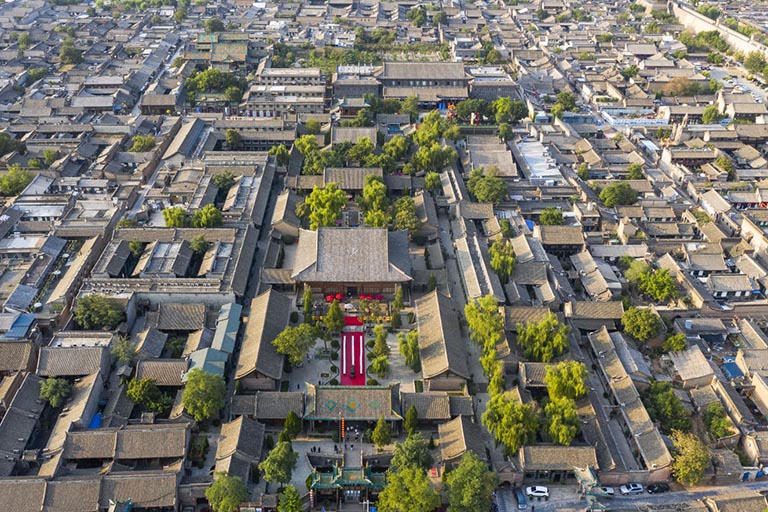 Pingyao Ancient City
Pingyao Ancient City
Zhenguo Temple
Distance from Shuanglin Temple: about 20 km, 0.5 hours’ driving
Ticket: CNY 25
Built in 963 and reconstructed in 1816, Zhenguo Temple is a temple of over one thousand years of history, which most notable for its ingenious mortise and tenon joint structure by wood. It has the two parts, the front and back courtyards which different halls. After seeing the Heaven Kings Hall, you can walk to Wanfo Hall to observe the giant and complicated eaves built in Tang Dynasty feature which are seen like outspread wings. In Three Buddhas Tower in back courtyard, massive murals are displayed on the walls showing the lifetime of Sakyamuni. Also, don’t miss the elegant statue of Svalokitesvara and other Buddha sculptures.
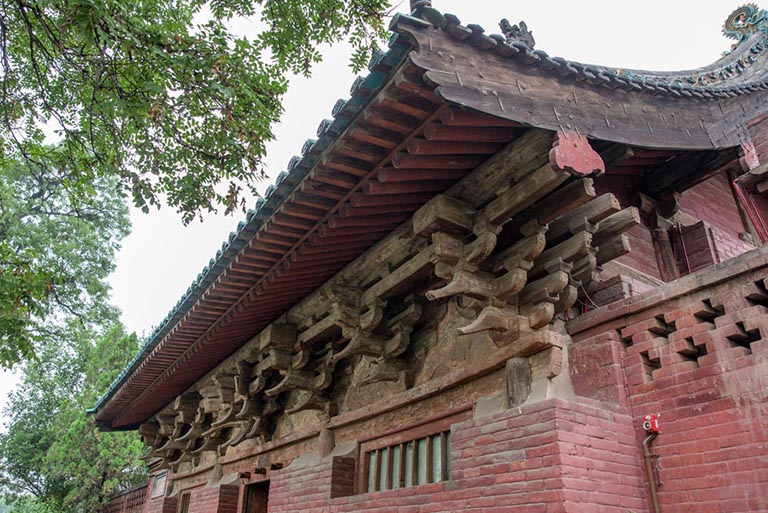 Zhenguo Temple
Zhenguo Temple
Wang’s Family Compound
Recommended Visiting Time: half a day
Ticket: CNY 55
Built by Wang's family in Jinsheng, Shanxi during the Ming and Qing Dynasties for more than 300 years with over 250,000 square meters, Wang's Family Compound is one of the biggest and best-preserved ancient residential complexes in the traditional architectural style of northern Chinese. With an area of over 250,000 square meters, the compound consists of five lanes, six fortresses, and one street. It is exquisite, beautiful, novel, elegant, and delicate in many ways, expressing the honor and well-ordered regime of ancient official houses.
 Wang's Family Compound
Wang's Family Compound
How to Plan Your Pingyao Tour with Shuanglin Temple
Best time to visit Pingyao: March to mid-June, mid-September to November, and Chinese Spring Festival Time (Jan or Feb)
Where to Stay: Mainly in Pingyao Ancient City
Travelers usually visit Shuanglin Temple together with Pingyao Ancient City. First, you can take 1 full day to visit major scenic spots in Pingyao Ancient City. After entry, first start from the Ancient City Wall, get a panorama view of the internal and climb up to the Ancient City Wall to get a panorama view of the internal and external and obvious contrast of ancient and modern city landscape. Then, move to Rishengchang Former Bank to learn how the wide ancients national wide financial system and created the first modern bank in China. Next, go to Ming and Qing Dynasties Street to image previous commercial boom and observe current local life. Later, visit Temple of the City God to admire wonderful architectures, carvings in the old temple.
And in next morning, drive to Shuanglin Temple to marvel at thousands of terrific painted clay Buddhist sculptures. Immerse in the strong Buddhist culture and breathtaking folk Chinese art. If time allows, you may make an in-depth culture discovery around Pingyao, visit Wang’ Family Compound and Zhangbi Ancient Castle.
✔ 2 Days Classic Pingyao Ancient City Tour
✔ 3 Days Pingyao Discovery Tour
Shanxi is great tourist regions rich in different kinds of attractions, including culture and nature both. After your Pingyao Ancient City tour, you may extend the trip further to Datong, Wutaishan and Hukou Waterfall in Shanxi, or arrange a longer China tour with Beijing, Xian, Shanghai and other top destinations. You can select from our popular Pingyao tours, or let us customize a special trip based on your requirements.
✔ 4 Days In-depth Pingyao & Taiyuan Tour
✔ 4 Days Essence of Datong & Pingyao Tour
✔ 3 Days Yellow River Hukou Waterfall Tour from Pingyao
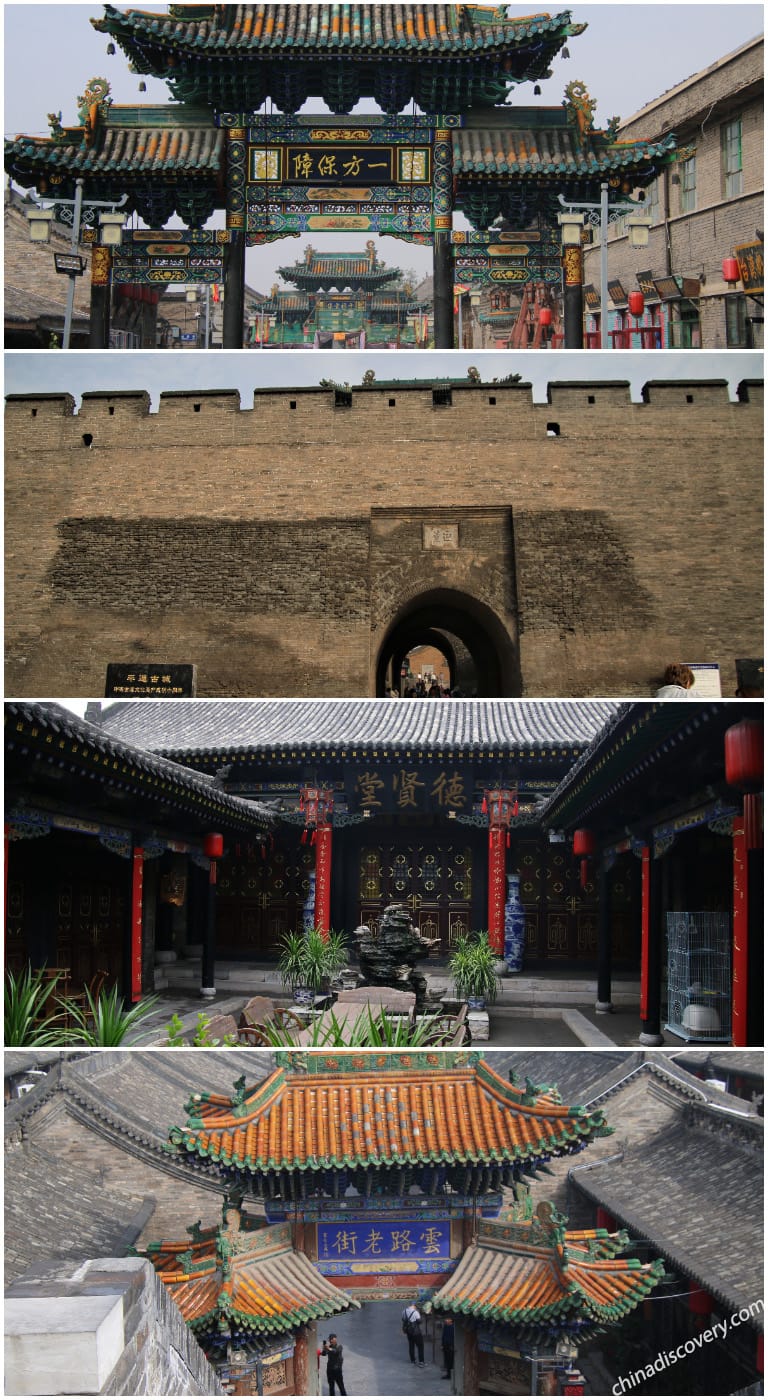 Major Sites in Pingyao Ancient City
Major Sites in Pingyao Ancient City
More Attractions in & near Pingyao
Pingyao Travel Guide
- Popular Pingyao Tours 2025
- Ultimate Pingyao Travel Guide
- Pingyao Trip Planner
- Top Things to Do
- Top Pingyao Attractions
- Wang's or Qiao's Family Compound
- Featured Nightlife, Activities & Festivals
- How to Get to & around Pingyao
- Pingyao Weather & Seasons
- Where to Stay in Pingyao
- Useful Pingyao Travel Maps
Other Popular Shanxi Destinations
Recommended Pingyao Tours
Top 3 Pingyao tours chosen by most customers to explore Pingyao in the best way. Check the detailed itinerary, or tailor your own trip now with us.

3 Days Taiyuan Pingyao Brief Tour
Taiyuan / Pingyao

4 Days Ancient Pingyao & Xian Tour
Pingyao / Xian
Start planning your tailor-made holiday to China by contacting one of our specialists. Once inquired, you’ll get a response within 0.5~23.5 hours.
Customize a TripHave a question? Get answers from our travel experts or guests
- Your Question:
- Your Name:
- Your Email:
- Submit

























